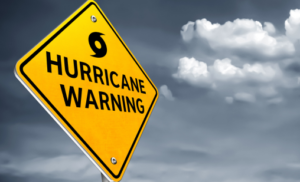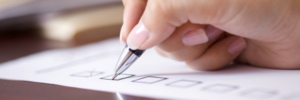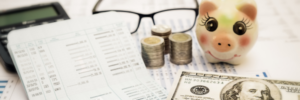If you live in Central Florida, then summer is a time for vacation and, of course, hurricanes. Hurricane season runs from June 1st until November 30th, with the most storms occurring from August to the end of October.
The last disastrous hurricane to pass through Florida—Hurricane Ian—was a Category 4, which left many repairing and rebuilding their homes, even their lives. However, with proper preparation, you and your family can be ready for when the next hurricane passes through the state.
This article will explore how to prepare for hurricane season in Central Florida. We’ll discuss tips for protecting your home from hurricane damage, some hurricane season essentials, and more.
By the end of this article, you’ll know the basics behind Central Florida hurricane preparedness and learn how to prepare, whether you live in a cottage home like those in Lakeshore by Simple Life or another community.

What Are the Risks of Hurricanes in Central Florida?
Fortunately, if you live near Orlando or Central Florida, you will be pleased to know that you are in one of the safest places in the state regarding hurricanes. This doesn’t mean that the storms never pass through, as even Disney or Universal have closed their parks on the worst storm days.
However, it does mean you’re less likely to experience the sometimes life-threatening winds, storm surges, and other hurricane-related challenges that people on the coast usually do.
Creating Your Hurricane Preparedness Plan
Even though you are in one of the safest places in Florida, you still need a hurricane preparedness plan in place, especially before you complete any hurricane season home prep. The first step to any plan of the sort is to write down emergency numbers and keep them on your fridge or near every phone you have. You should also have them available on your cell phone. You should also have an emergency supply kit.
Your emergency supply kit should include the tools you need to stay safe, such as a radio, flashlight, dry food, bottled water, prescriptions, a first aid kit, power sources like portable chargers, and even necessary paperwork, such as insurance cards, ID cards, and more.
Another step in your hurricane preparedness planning is to make sure you know where the nearest shelter is and the closest evacuation routes. If needed, you should plan for alternate routes. It’s also a great idea to have some cash on hand and to fill your gas tank.
In a community like Lakeshore by Simple Life, you might even be able to coordinate with neighbors to ensure that you all take care of one another and that everyone has a solidified evacuation plan if needed.

How to Secure Your Home’s Exterior
If you are preparing your home for the hurricane coming soon, you will need to secure the exterior, including the roof, doors, and windows. Many homes may have storm shutters that you can put over your windows to protect them from damage.
You can also use sandbags in front of doors to prevent flooding, especially if you live near a water source. If you have any loose items outside, like outdoor furniture, you’ll want to bring them inside, in your garage, or secure them.
Protecting the Interior of Your Home from Hurricane Damage
For the inside of your home, the sandbags will help you avoid flooding or, at the very least, reduce it significantly in the event of a significant storm. Other steps that you can take include using waterproof storage for your essential documents and valuables.
One of the best hurricane safety tips we can provide is to set up a safe room for your valuables or a space to shelter from the storm. With a property like those at Lakeshore by Simple Life, you can use one of the flex spaces to store your valuables from harm.
Don’t Forget to Stock Up on Hurricane Season Essentials!
As we mentioned above, you should create a hurricane emergency supply kit. Everyone’s emergency kits will differ from household to household, but here are some everyday items that should be in your kit to ensure you’re protected during the storm:
- Water – at least one gallon per person per day
- Food – at least several days’ worth of non-perishable food
- Hand-crank radio or battery-powered radio
- Flashlight
- First aid kit
- Extra batteries
- Whistle – to call for help
- Dust mask – to filter contaminated air
- Plastic sheeting, scissors, and duct tape – to shelter in place
- Moist towelettes or wipes, garbage bags, and plastic ties – for personal hygiene
- Manual can opener – for food
- Local maps
- Cell phone
- Prescription medications
- Cash
- Important documents
- Change of clothes per person
Pack these items to be prepared for the storm. If possible, take advantage of Florida’s annual Disaster Preparedness Sales Tax Holiday.
Tips for Insurance and Financial Preparedness
Finally, the last step you should take in preparing for hurricanes in Central Florida is to review and update your home’s existing home insurance policies. Ensure you understand what is and is not covered, and prepare emergency funds before the storm. Your critical financial documents should be protected.

Stay Informed Throughout Hurricane Season
To keep up to date on the weather forecast, you can visit NOAA or your local weather channel to see the latest insights on new or developing Atlantic storms. Your local news, as will the National Hurricane Center, will be an invaluable source of insight.
If you lose power, you can keep informed by listening on a hand-crank radio. Those who live in a community like Lakeshore by Simple Life can also wait for community updates to be shared through the appropriate communication channels.
What Do You Do After the Hurricane?
Even after following all of these hurricane safety tips, you still need to be mindful after the hurricane has passed. Wait until it is safe to assess the damage before you go outside. If you have been evacuated, you should wait until the authorities tell you that you can return home. If you need medical attention, it is best to find it as soon as possible.
While assessing the damage, avoid power lines, including puddles near them. You should also board up broken windows and arrange repairs on any part of your home needing attention. This includes potential gas or water line breaks. As you repair your house after the storm, keep track of expenses. You may be able to get reimbursed through your home insurance, depending on your policy.
For those who live in a community like Lakeshore by Simple Life, you can also lean on the community for support during recovery, as they will help clean up the community to restore it to its original splendor.
Take Steps to Protect Yourself from the Next Hurricane
Central Florida hurricane preparedness is important, even if this region is among the safest in the state. With a proper hurricane preparedness plan and the right hurricane season essentials, you and your family will be protected. If you are looking to move into a community that provides support and guidance on protecting your home from hurricane damage and more, why not consider Lakeshore by Simple Life? For more information about this fantastic cottage-style community, visit our website today.





